Learn more about Hart Energy Conferences
Get our latest conference schedules, updates and insights straight to your inbox.
After the devastating effects of the COVID19 pandemic on the energy market, the oil and gas industry did what it could to rebound—and with a fair amount of success. According to the Energy Information Administration (EIA), however, the market isn’t close to seeing its 2019 success rates
“A return to 2019 levels of U.S. energy consumption will take years; energy-related carbon dioxide emissions fall further before leveling off or rising,” the EIA’s 2021 annual report presentation stated.
Stay-at-home mandates contributed to the decline in energy consumption and GDP seen in 2020, and “the pace at which both will return to 2019 levels remains uncertain,” the report stated.
“Petroleum remains the most-consumed fuel in the United States, as energy-related carbon dioxide emissions dip through 2035 before climbing in later years,” the EIA said. “The energy intensity of the U.S. economy continues to fall as end-use sector intensities decline at varying rates.”
Even amid the energy crisis, the U.S. is one of the largest global suppliers of crude oil and natural gas. The processing of crude oil in the U.S. is expected to bounce back to 2019 levels by 2025 after falling in 2020.
“The oil and natural gas industry was already headed toward relying on capital from cash flow instead of debt and equity,” the EIA stated. “COVID-19 has accelerated this trend, leaving producers more dependent on internal sources of cash flow because outside funding sources are less available or require higher rates of return.”
The EIA expects a lower price path to decrease U.S. oil production rates in the short and medium term in AEO2021 compared to AEO2020. According to the report, “the oil price is the primary driver of projected drilling activity and accompanying U.S. crude oil production rates” in AEO2021.
In partnership with Rystad Energy, Hart Energy has identified the top 40 key players. Rystad compiled the list of companies based on first-quarter 2021 gross operated production as well as number of wells put on production in that same quarter (both volumes and well count only reflected unconventional activity). This section highlights a year review of U.S. activity for these shale leaders.
Editor’s note: The following profiles were written based on the companies’ second- and third-quarter 2021 results, as this is what was available when the publication went to print.
KEY PLAYERS >>>
Aethon Energy – private
Aethon Energy is a private investor and operator of onshore oil and gas properties in the U.S. based in Dallas. Founded in 1990, it has grown through its vertically integrated business model to become the largest private natural gas producer in the core of the Haynesville Shale.
The concentration and scale of Aethon’s assets across the Haynesville Shale benefit from the proximity to growing demand centers along the Gulf Coast. Aethon is a leading operator with significant midstream gathering assets to support its upstream development. The scale of Aethon’s vertically integrated approach provides one of the lowest overall cost structures in the dry gas industry.
RELATED:
Aethon Energy Reportedly Seeking $6 Billion Sale of Haynesville Assets
Aethon’s net acreage exceeds 350,000 acres, generating more than 1.5 Bcfe/d in net production, and its midstream infrastructure encompasses ~1,400 miles of pipe, nine treatment facilities and throughput capacity of approximately 2.8 Bcf/d.
Antero Resources – public
Antero Resources operates in the Marcellus Shale with 515,000 net acres and operated more than 1,000 producing horizontal wells as of fourth-quarter 2020, as well as 91,000 net acres in the Utica Shale as of fourth-quarter 2019, according to the company’s website.
In third-quarter 2021, Antero produced a net average of 10,131 bbl/d of oil, 2,232 MMcf of natural gas, 111,505 bbl/d of NGL, 47,519 bbl/d of ethane and 3,247 MMcfe/d of combined natural gas equivalent, according to its third-quarter financial and operational report. The company placed 16 horizontal wells in the Marcellus Shale with an average lateral length of 13,448 ft, nine of which have been online for at least 60 days. The average 60-day rate was 24.9 MMcfe/d per well, including about 1,370 bbl/d of liquids.
Antero set a company record during the third quarter for completion stages with 23 stages per day in the Marcellus, a 28% increase in the company’s first simul-frac. It is operating three drilling rigs and one completion crew.
APA Corp. – public
Apache Corp., a wholly owned subsidiary of APA Corp., operates in the Permian Basin (4.9 million acres) with more than 7,000 wells as of Dec. 31, 2020, according to the company website. The company also has smaller holdings in the Eagle Ford Shale and Austin Chalk Basin, its website stated.
APA’s third-quarter 2021 report stated that the company produced 237,498 boe/d in the U.S., a slight decrease from 241,525 boe/d in the previous quarter, of which 38% was gas, 32% was oil and 30% was NGL. The company drilled 10 gross wells and completed seven net wells with an average of two rigs in the third quarter, with nine new wells placed on production in the southern Midland Basin. In 2020 the U.S. total production was 93.7 MMboe.
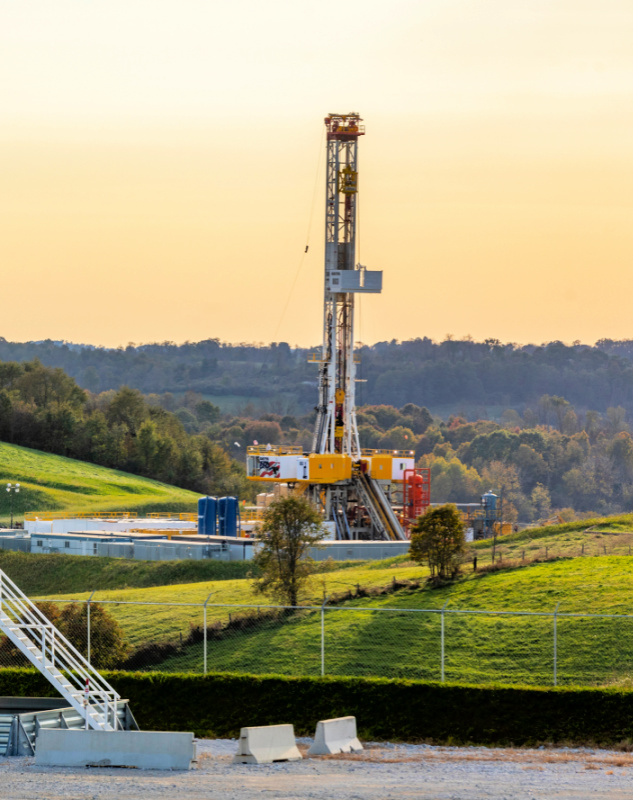
Ascent Resources LLC – private
Ascent Resources Utica Holdings LLC is a private equity-backed company with operations in the Utica Shale in southern Ohio. The company has approximately 335,000 net leasehold acres, including 79,100 mineral acres in the heart of the play, according to the company’s website.
Net production as of third-quarter 2021 was about 2 Bcfe/d, of which 93% was natural gas, Ascent Resources stated. The company operated four rigs during the third quarter and spud 19 wells, completed 20 wells and turned inline 17 wells with an average lateral length of 13,220 ft.
“Ascent Resources is one of the largest private producers of natural gas in the U.S. based on daily production and the largest producer of natural gas in Ohio,” the website stated.
Bayswater – private
Bayswater is a Denver-based private equity company that primarily operates in the Denver-Julesburg Basin Wattenberg Field (21,000 net acres) and the Midland Basin (36,200 net acres). The company has also accumulated interests in the Delaware Basin (11,000 net royalty acres) and the Powder River Basin (24,000 net acres), according to the company website.
“Bayswater prides itself on creating substantial value for our partners and shareholders and enhancing the wealth and well-being of the communities in which we work by linking technology, opportunities, talent, capital and executional excellence,” the website stated.
Bayswater’s website reports that the company is producing 17,000 boe/d in the Wattenberg and 6,000 boe/d in the Midland Basin. Bayswater has also amassed a mineral profile in the Delaware Basin, which is projected to cash flow $25 million in 2021.
BP – supermajor
BPX Energy, which comprises BP’s onshore oil and gas operations in the Lower 48, operates in the Haynesville Shale (1.7 million net acres), Eagle Ford Shale (588,000 net acres) and Permian Basin (84,000 net acres), according to a December 2020 BP investor presentation.
In BP’s third-quarter 2021 results, the company reported an average of two rigs in the Permian, two rigs in the Eagle Ford and two rigs in the Haynesville. This is comparable to the eight rigs operating in second-quarter 2021, as stated in the report. Between the three shale plays, BPX produced 130,000 bbl/d of liquids (crude oil, condensate and NGL), 1,115 MMcf/d of natural gas and 322 Mboe/d of total hydrocarbons in the third quarter, according to the report. This is an 18% increase from the previous quarter’s production, which reached 106,000 bbl/d of liquids, 971 MMcf/d of natural gas and 273,000 boe/d of total hydrocarbons.
Comparing the third quarter of 2021 versus 2020, BP reported underlying production was higher reflecting major project ramp-up partially offset by impacts from reduced capital investment, decline and weather impacts in the U.S. Gulf of Mexico. Looking ahead, the company stated fourth-quarter 2021 production is expected to be higher than third-quarter 2021 levels “reflecting major project ramp-up, mainly in gas regions, recovery from seasonal maintenance activity and continuing impacts from Hurricane Ida on our nonoperated production in the U.S. Gulf of Mexico.”
Chesapeake – public
Chesapeake Energy operates in the Haynesville Shale (348,000 net acres, six active rigs), Marcellus Shale (540,000 net acres, three active rigs), Eagle Ford Shale (220,000 net acres, one active rig), Brazos Valley Basin (420,000 net acres) and Powder River Basin (190,000 net acres, 25 active rigs), according to the company website.
In third-quarter 2021, Chesapeake’s average net production rate was approximately 436,000 boe/d, comprising approximately 80% natural gas and 20% total liquids, the company stated in its third-quarter earnings press release. It operated three rigs in Appalachia, six rigs in the Gulf Coast, one rig in the Eagle Ford and one rig in the Powder River Basin.
In fourth-quarter 2021, Chesapeake completed the acquisition of Vine Energy. Chesapeake president and CEO Nick Dell’Osso said in regard to the acquisition, “We are pleased to integrate the outstanding Vine operations and assets into our portfolio, strengthening our position in the Haynesville Shale with over 900 additional drilling locations, immediately improving our free cash flow profile and accelerating a significant return of capital to our shareholders at a time of favorable natural gas prices.”

Chevron – supermajor
Chevron Corp. develops unconventional oil and gas resources, primarily operating in the Permian (2.2 million net acres) and the Denver-Julesburg Basin (327,000 net acres), according to the company’s website.
For Chevron’s U.S. upstream operations, third-quarter 2021 net production was 1.13 MMboe/d, up 145,000 boe/d compared to a year earlier, according to Chevron’s third-quarter 2021 earnings report. The surge in net oil equivalent production is in part due to the acquisition of Noble Energy in fourth-quarter 2020, allotting Chevron an additional 224,000 bbl/d, partially offset by a 69,000-bbl/d decrease related to the Appalachian asset sale. Chevron completed its acquisition of Noble Midstream in second-quarter 2021.
In October 2021, Chevron announced it had adopted a 2050 net-zero goal for equity upstream Scope 1 and 2 emissions.
Civitas – public
Civitas formed in May 2021 from a merger between Extraction Oil & Gas and Bonanza Creek Energy Inc. The company operates in the Denver-Julesburg Basin with 525,000 net acres, according to its website.
As of the end of third-quarter 2021, Civitas produced approximately 159 Mboe/d, of which 40% was oil, 35% was gas and 25% was NGL, the company’s November 2021 investor presentation stated. The company holds 315 MMcf/d of gas gathering capacity with 280 miles of gas gathering, gas-lift and sales lines, and 77 MMbbl/d of oil capacity with 35 miles of total oil gathering.
In the second quarter, shortly after the formation of the company, Civitas acquired Crestone Peak Resources in an all-stock deal, according to a press release issued June 7. The acquisition increased Civitas’ production to 160,000 bbl/d and increased proven reserves of the equivalent to 530 MMbbl.
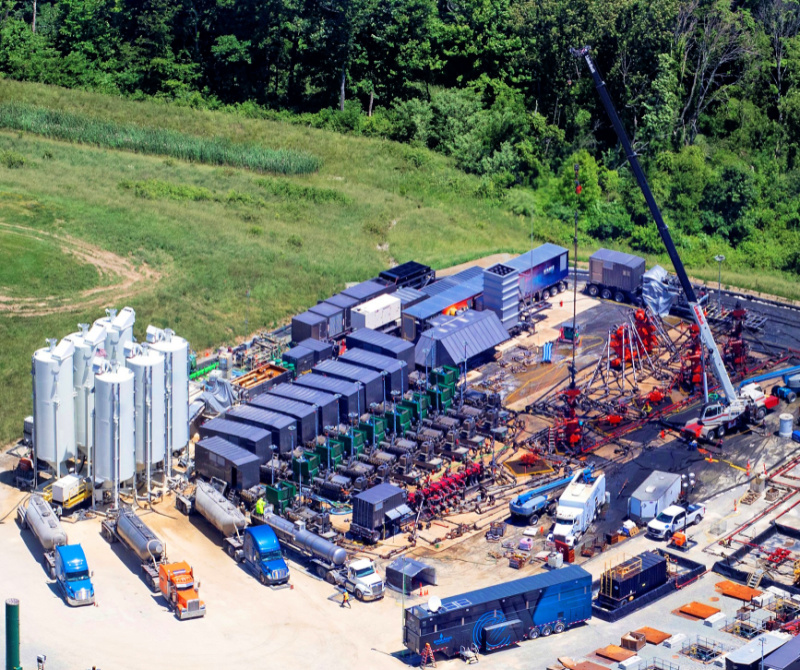
CNX Resources Corp. – public
CNX Resources Corp. operates in the Marcellus and Utica shales, with an average well lateral length of 12,000 lateral ft in the Marcellus and 14,500 lateral ft in the Utica, according to the company’s third-quarter 2021 earnings results report.
The report stated that CNX’s average daily production increased to 1,668.7 MMcfe in the third quarter from 1,562.5 MMcfe in the first quarter and 1,515.6 MMcfe in the second quarter. Shale sales volumes rose to 130.3 Bcf from 121.1 Bcf in the first quarter and 115 Bcf in the second quarter, but coalbed methane sales volumes fell to 12.2 Bcf from 12.7 Bcf in the first quarter and 12.6 Bcf in the second quarter. NGL sales volumes increased from 6.5 Bcfe in the first quarter and 9.5 Bcfe in the second quarter to 10.1 Bcfe, and oil and condensate sales volumes rose from 0.3 Bcfe in the first quarter and 0.7 Bcfe in the second quarter to 0.8 Bcfe in the third quarter.
Comstock Resources – public
Comstock Resources operates in the Haynesville/ Bossier Shale with 323,000 net acres, according to the company website.
In its third-quarter 2021 financial report, Comstock reported its total production increased 25% to 1,424 MMcfe/d from the same quarter in 2020. Oil production dipped 2% to 3.67 Mbbl/d from 3.85 Mbbl/d in 2020, and gas production increased 26% from 1,115 MMcf/d in 2020 to 1,401 MMcf/d. The company completed 15 operated wells in the third quarter with an average lateral length of 7,925 ft. and an average IP rate of 22 MMcf/d.
In fourth-quarter 2021, Comstock partnered with MiQ “to independently certify its natural gas production in North Louisiana and East Texas,” according to a press release on Nov. 2. The release stated that Comstock will use the MiQ Standard for its facilities in North Louisiana and East Texas, “which currently produce approximately 2 billion cubic feet per day of natural gas.”
ConocoPhillips – public
In the Lower 48, ConocoPhillips operates primarily in the Permian (~750,000 net acres), Bakken (~610,000 net acres) and Eagle Ford (~200,000 net leasehold and mineral acres) basins, with smaller holdings in the Anadarko (~283,000 net acres) and Wyoming/Uinta (~44,000 net acres) basins, according to the company’s year-end 2020 Lower 48 report.
ConocoPhillips reported third-quarter 2021 total production of 1,507 Mboe/d, up 441 Mboe/d from 981 Mboe/d in third-quarter 2020, according to a press release containing its third-quarter earnings. In its Lower 48 holdings, third-quarter 2021 production averaged 790 Mboe/d, with 445 Mboe/d from the Permian Basin, 217 Mboe/d from the Eagle Ford Basin and 95 Mboe/d from the Bakken.
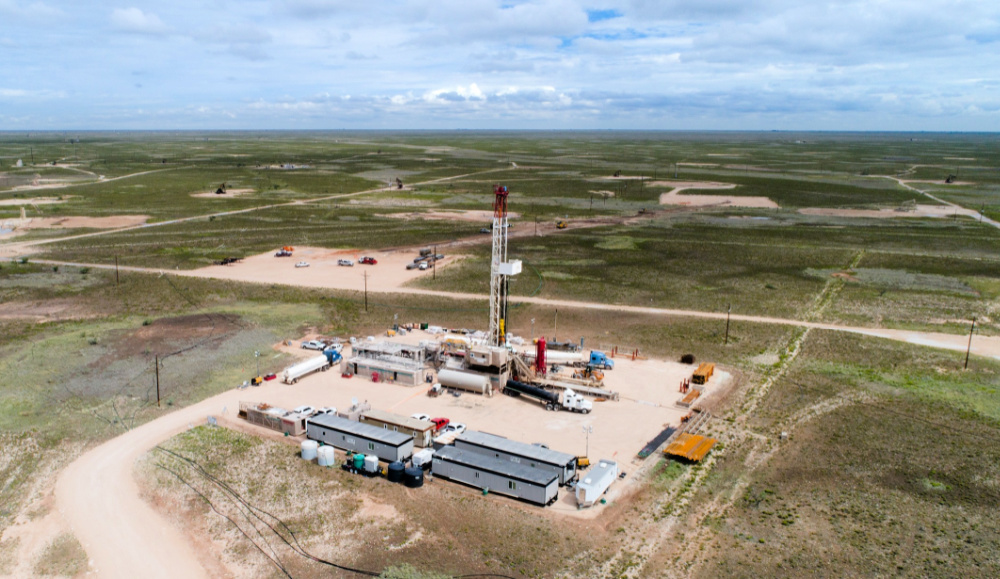
Continental Resources – public
Continental Resources operates in the Bakken Shale in North Dakota and Montana and the STACK/SCOOP in Oklahoma, according to its third-quarter 2021 earnings report. The company also acquired a position in the Powder River Basin play in Wyoming and acquired Pioneer Natural Resources’ Delaware Basin assets in fourth-quarter 2021.
The report stated that the company’s Bakken holdings produced 167,604 boe/d in the third quarter, up from 160,661 boe/d the same time in 2020, and the STACK/SCOOP holdings produced 152,543 boe/d, increased from 129,583 boe/d in third-quarter 2020. Between the two shales, average crude oil production was 157,153 bbl/d, average natural gas production was 1,045,521 Mcf/d and average production of crude oil equivalents was 331,407 boe/d.
Continental Resources had 143 gross operated wells and 85 net operated wells in the Bakken, with an average of seven rigs in second-quarter 2021. In the STACK/ SCOOP, it had 67 gross operated wells and 54 net operated wells with four average rigs, according to the company’s second-quarter 2021 earnings press release.
Coterra Energy – public
Coterra Energy Inc. was formed in early fourth-quarter 2021 through a merger between Cabot Oil & Gas Corp. and Cimarex Energy Co. The company operates in the Permian Basin (234,000 net acres), Anadarko Basin (189,000 net acres) and Marcellus Shale (173,000 net acres), as stated on its website.
According to the company’s earnings presentation, during third-quarter 2021, Coterra’s average production for the combined assets was 645 Mboe/d, including 81.5 Mbbl/d of oil and 2,945 MMcf/d of natural gas. The company’s earnings press release stated that the Marcellus Shale operated two rigs and two completion crews in the third quarter, and the Permian operated five rigs and two completion crews.
The presentation stated that Coterra put 25 net wells on production in the Permian, 31 wells in the Marcellus and five wells in the Anadarko. It also drilled 17 wells and completed 30 wells in the Marcellus. It anticipates putting 17 to 20 wells on production in the Permian and drilling 19 wells in the Marcellus in fourth-quarter 2021.
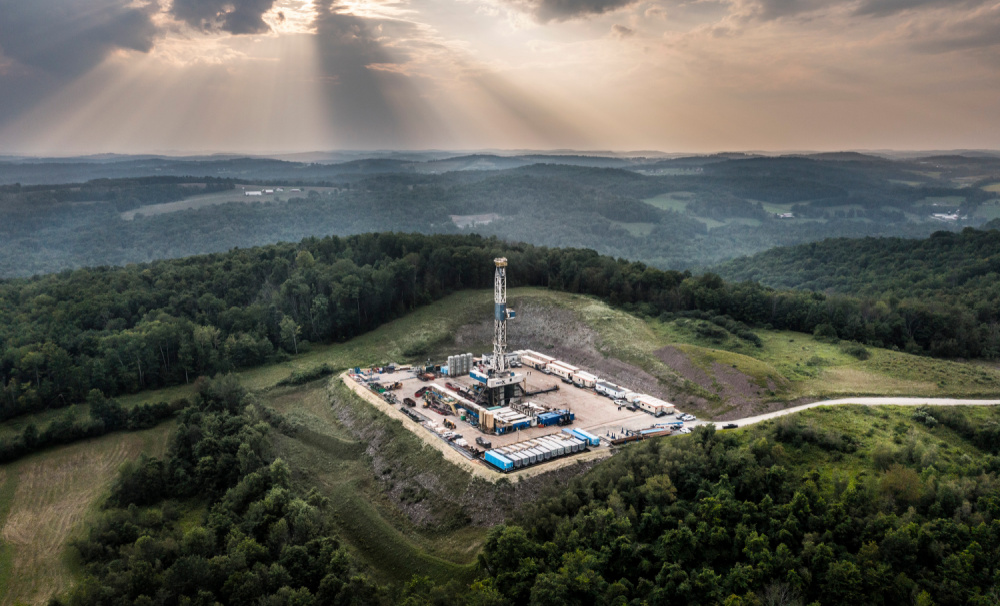
CrownQuest – private
CrownQuest is the operating name for CrownRock LP, which was formed with private equity provider Lime Rock Partners in 2007. The company operates almost exclusively in the Midland Basin (~90,716 net acres). The company also holds acreage in the Eastern Shelf (~105,000 net acres) of the Permian Basin as well as smaller amounts of acreage in other basins, according to the company website.
CrownQuest produces about 125,000 net boe/d from approximately 1,372 wells, more than 400 of which are horizontal. Current and forward-looking development plans include drilling and completing roughly 150 multi-layer horizontal wells per year in its core Midland Basin position, where the company has already invested approximately $3.6 billion since 2015. CrownQuest assets also include significant surface ownership, a water source and disposal system, and a mineral position in the Permian Basin.
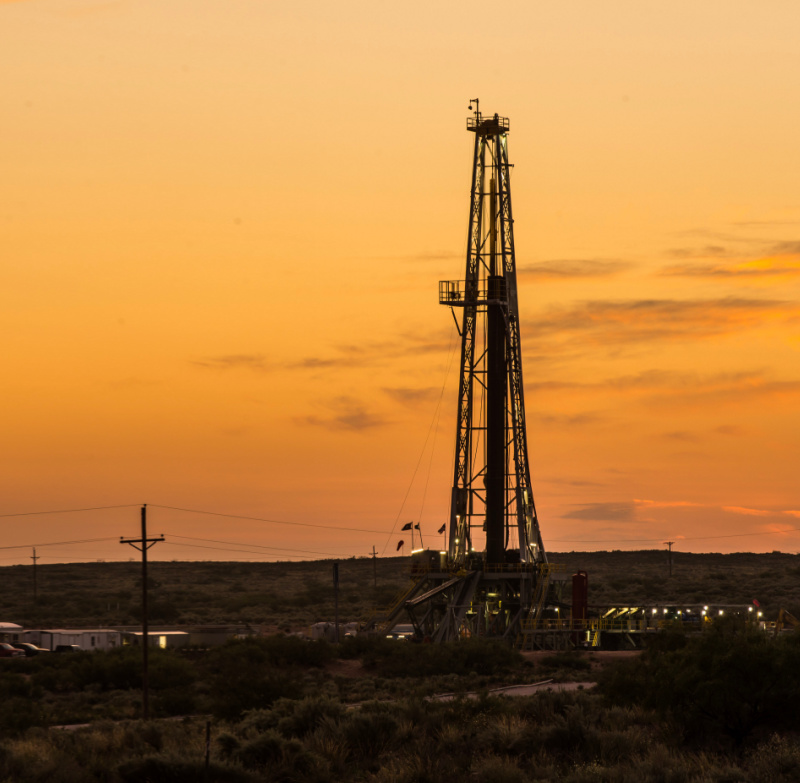
Devon Energy – public
Devon Energy operates in the Delaware Basin (400,000 net acres), Williston Basin (85,000 net acres), Powder River Basin, Anadarko Basin and Eagle Ford Shale, according to the company’s website.
According to Devon’s third-quarter 2021 earnings supplement, the Delaware Basin produced 213 Mbbl/d of oil, 100 Mbbl/d of NGL, 578 MMcf/d of gas and 409 Mboe/d of total oil equivalent. The Anadarko Basin produced 14 Mbbl/d of oil, 25 Mbbl/d of NGL, 219 MMcf/d of gas and 75 Mboe/d of total oil equivalent. The Williston Basin produced 39 Mbbl/d of oil, 9 Mbbl/d of NGL, 59 MMcf/d of gas and 58 Mboe/d of total oil equivalent. The Eagle Ford produced 20 Mbbl/d of oil, 11 Mbbl/d of NGL, 67 MMcf/d of gas and 42 Mboe/d of total oil equivalent. The Powder River Basin produced 14 Mbbl/d of oil, 3 Mbbl/d of LNG, 19 MMcf/d of gas and 20 Mboe/d of total oil equivalent.
Devon’s third-quarter 2021 earnings presentation stated that the company brought 81 wells online as well as ran 16 operated rigs and five completion crews across its assets.
For more check out our executive Q&A with Devon Energy’s executive vice president and COO, Clay Gaspar, in the December 2021 issue of Oil and Gas Investor.
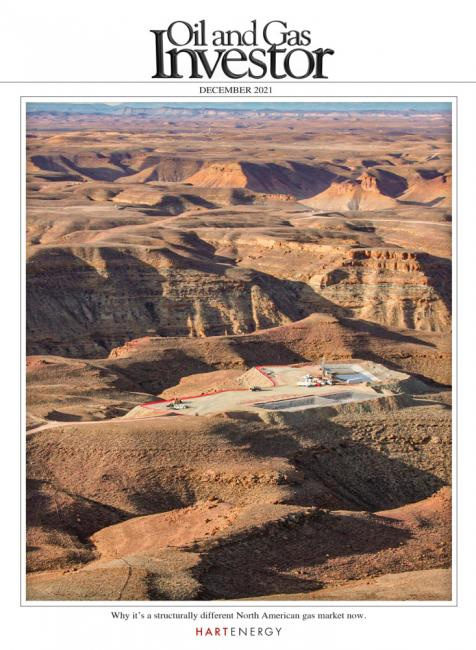
Diamondback Energy – public
Diamondback Energy is a pure play Permian operator after closing the divestiture of its Williston Basin assets on Oct. 21, 2021, according to the company’s third-quarter announcements press release.
The release also stated that oil production averaged at 22,058 Mbbl in the third quarter compared to 22,067 Mbbl in the second-quarter. Natural gas production rose to 45,571 MMcf from 44,506 MMcf in the second quarter, and NGL increased from 7,047 Mbbl in the second quarter to 7,540 Mbbl in the third quarter, with combined volumes averaging at 37,193 Mboe in the third quarter as opposed to 36,532 Mboe in the second quarter. Oil volumes dipped from 242,495 bbl/d in the second quarter to 239,761 bbl/d, and combined volumes rose from 401,451 boe/d the previous quarter to 404,272 boe/d.
In third-quarter 2021, Diamondback drilled 47 wells and completed 63 wells in the Midland Basin and drilled 11 and completed 10 wells in the Delaware Basin, according to its third-quarter announcements press release. In the first three quarters of the year, the company drilled 135 gross horizontal wells in the Midland Basin and 28 in the Delaware Basin.
Encino Energy – private
Encino Energy is backed by the Canada Pension Plan Investment Board. Encino Acquisition Partners LLC was formed in 2017 in partnership with CPP Investments to build a sustainable and profitable large-scale gas, oil and liquids production company. It operates in the Utica Shale with 1 million net acres with 29 Tcfe of recoverable reserves.
Since 2018 Encino has driven down well costs per lateral foot by about 50% and doubled productivity per foot. With what Encino thinks are the lowest costs per foot in the basin, combined with the oil and liquids revenues, the company’s margins are approaching best in class, according to Encino.
With a primary focus in the Utica Shale, the company’s long-term strategy of building a sustainably profitable business considers value-driving strategic acquisitions. Encino is looking actively at multiple transactions and expects it will continue growing both with the drill bit and through acquisitions.
Endeavor Energy Resources – private
Endeavor Energy Resources operates in the Permian Basin with more than 250,000 net acres in the Midland Basin and 500,000 net acres in the rest of the Permian, the company’s website stated.
“With a large asset position of over 350,000 net acres in the Midland Basin, Endeavor is poised for unparalleled growth as it executes its drilling program,” the website stated. “An estimated 98% of Endeavor’s assets in the Midland Basin have yet to be drilled.”
In a press release reporting the company’s second-quarter 2021 results, Endeavor reported net production of 185.2 Mboe/d, which is an 18% increase from its production of 156.5 Mboe/d at the same time in 2020. Total net production in second-quarter 2020 was 14.2 MMboe, increasing to 16.9 MMboe in second-quarter 2021, in part due to higher prices for crude oil, natural gas and NGL. Endeavor also spud 72 gross operated wells and placed 31 gross operated wells on production in the quarter, the release stated.
EOG Resources – public
EOG Resources operates in the Williston Basin, Powder River Basin, Permian Basin, Anadarko Basin, Eagle Ford Shale, Barnett Shale, South Texas Shale and Upper Gulf Coast Shale in the U.S., according to the company’s website.
In EOG’s second-quarter 2021 earnings press release, it reported a total of 828.0 Mboe/d in crude oil equivalent volumes across all its holdings. The U.S. reported 446.9 Mbbl/d in the second quarter in crude oil and condensate production, up from 428.7 Mbbl/d in the first quarter and an increase of 5.9 Mbbl/d from its second-quarter guidance midpoint. NGL production totaled 138.5 Mbbl/d, increased from 124.3 Mbbl/d in the first quarter and 6 Mbbl/d higher than the second-quarter guidance midpoint. U.S. natural gas production totaled 1,199 MMcf/d, increased from 1,100 MMcf/d in the first quarter and 39 MMcf/d higher than the second-quarter guidance midpoint.
For third-quarter 2021, EOG reported its guidance range for crude oil and condensate production is 440 Mbbl/d to 447 Mbbl/d, 135 Mbbl/d to 145 Mbbl/d for NGL production, 1,150 MMcf/d to 1,250 MMcf/d for natural gas production and 766.7 Mboe/d to 800.3 Mboe/d for crude oil equivalent production.
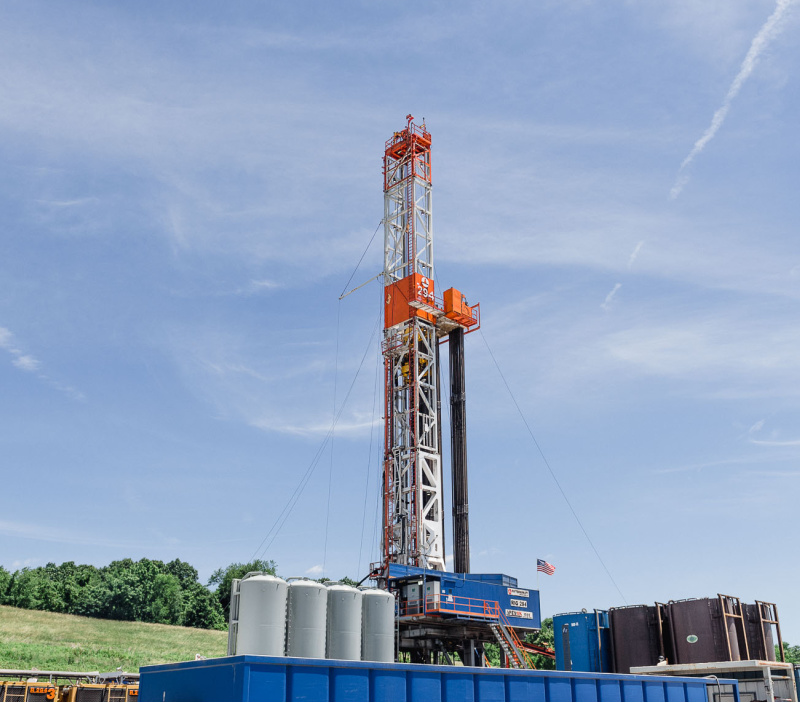
EQT Corp. – public
EQT Corp. is the largest natural gas producer in the U.S., producing 5.6 Bcfe/d and owning or leasing approximately 640,000 net core acres in Pennsylvania, 240,000 net core acres in West Virginia and 60,000 net core acres in Ohio, according to EQT’s latest investor presentations.
According to the company’s third-quarter earnings press release, EQT horizontally drilled three wells with an average net lateral of 12,700 ft and completed two wells with a net average lateral of 11,700 ft. In southwest Pennsylvania, it horizontally drilled 12 wells with an average net lateral of 15,320 ft and completed 21 wells with an average net lateral of 10,960 ft. In West Virginia, it horizontally drilled nine wells with an average net lateral of 12,820 ft. In the aggregate, the company turned inline 40 wells to sales with an average net lateral of 10,830 ft.
The release continued that the company plans to horizontally drill five wells in the fourth quarter in northeast Pennsylvania with an average net lateral of 12,190 ft, 26 wells in southwest Pennsylvania with an average lateral of 11,820 ft and one well in Ohio with an average net lateral of 12,960 ft. In the aggregate, the company plans to turn inline 25 wells to sales with an average net lateral of 11,820 ft.
Hear more from EQT President and CEO Toby Rice at Hart Energy’s DUG East conference.

Exxon Mobil – supermajor
Exxon Mobil Corp. operates in five states in the U.S.— California, Texas, Wyoming, Louisiana and Alabama— primarily in the Permian and Bakken shales.
In third-quarter 2021, Exxon Mobil reported 758,000 bbl/d in net production of crude oil, NGL, bitumen and synthetic oil, compared to 665,000 bbl/d in the first quarter and 687,000 bbl/d in the second quarter, as stated in the company’s third-quarter 2021 results report. Additionally, natural gas production decreased from 2,804 Mcf/d in the second quarter to 2,701 Mcf/d in the third quarter. Upstream U.S. capex for third-quarter 2021 totaled $976 million.
In December 2020, Exxon Mobil announced plans to reduce the intensity of operated upstream greenhouse-gas emissions by 15% to 20% by 2025, compared to 2016 levels, according to a company news release. The emission reduction plans, which cover Scope 1 and Scope 2 emissions from operated assets, are projected to be “consistent with the goals of the Paris Agreement,” the release stated. “The company also plans to align with the World Bank’s initiative to eliminate routine flaring by 2030.”
Great Western Oil & Gas – private
Great Western Oil & Gas operates in the Denver-Julesburg Basin in northern Colorado, specifically in the Wattenberg Field, according to the company’s website.
“As we expand our growth plans by extending our core areas, we are following proven strategic fundamentals,” the website stated. “We seek a lower risk, multi-faceted value creation proposition through operational efficiency improvements and enhanced recovery potential.”
In July 2021, Great Western’s Raindance Pad in Windsor, Colorado, began operation. The pad will help manage the company’s field locations by reducing emissions and “increasing pipe movement to have the most up-to-date facilities,” according to the company.
Gulfport Energy – public
Gulfport Energy operates in the Utica Shale of the Appalachian Basin with approximately 193,000 net acres and the SCOOP play of the Anadarko Basin with approximately 73,000 net reservoir acres, according to the company website.
In third-quarter 2021, Gulfport’s quarterly earnings press release reported the company produced 958 bbl/d of oil and condensate in the Utica shale, dipping slightly from 1,579 in third-quarter 2020, and 4,335 bbl/d in the SCOOP play, increasing from 3,204 bbl/d.
Natural gas production decreased from 763,387 Mcf/d to 678,154 Mcf in third-quarter 2021 in the Utica but rose from 139,233 Mcf/d to 188,292 Mcf/d inthird-quarter 2021 in the SCOOP. NGL production in the third quarter 2021 totaled 2,516 bbl/d in the Utica, decreasing from 2,917 bbl/d, and 9,918 bbl/d in the SCOOP, increasing from 7,128 bbl/d.
On May 17, Gulfport completed its restructuring process after emerging from bankruptcy. The company applied fresh start accounting, marking its start date May 17, according to the company’s second-quarter 2021 earnings press release.
Hess – public
Hess Corp. has a key position in the U.S. shale play—the North Dakota Bakken and Three Forks formations. The company is one of the largest producers in the Bakken and has approximately 460,000 net acres and an average working interest of about 75%.
The company’s focus remains on maximizing value from its current acreage position. Hess has approximately 2,200 future locations, which is over 70 rig years of inventory. Net production averaged 193,000 boe/d in 2020. In 2021 Hess added a second rig in February and a third rig in September.
Kaiser-Francis Oil Co. – private
Kaiser-Francis Oil Co. is a private oil and gas E&P company based in Tulsa, Okla., and operating in the Denver-Julesburg Basin.
According to a report by offshore-technology.com, which quoted data from GlobalData’s USL48 database, “The oil and gas production of Kaiser-Francis Oil grew 141.66% in August 2021 from 18,883.04 boe/d in August 2020. On a YTD [year to date] basis, the company’s total oil and gas production increased by 147.35% from the same period in 2020.”
The report also stated, “On a YTD basis, oil production increased by 128.73% in 2021 when compared with the same period in 2020, while gas production rose by 186.6%. Out of the total oil and gas production in August 2021, oil production held a 63.1% share, while gas production held a 36.78% share.”
Laredo Petroleum – public
Laredo Petroleum operates in the Permian Basin in 140,000 gross acres across the Wolfcamp and Cline formations, according to Laredo’s website.
In the company’s second- and third-quarter 2021 results press releases, it reported 3,250 Mbbl/d in oil production in the third quarter, up from 2,406 Mbbl/d in the second quarter, and 7,057 Mboe/d of production in the third quarter, a decrease from 7,819 Mboe/d in the second quarter. NGL production fell to 1,830 Mbbl/d from 2,551 Mbbl/d the previous quarter, and natural gas production decreased from 17,169 MMcf/d to 11,860 MMcf in the third quarter.
In the third quarter, Laredo had two drilling rigs and one completions crew in operation. It completed 18 wells and turned inline 19 wells, according to a press release.
On July 1, 2021, Laredo acquired Sabalo Energy, a portfolio company of EnCap Investments.
Marathon Oil – public
Marathon Oil operates in the Bakken Shale, Delaware Basin, SCOOP/STACK and Eagle Ford, according to the company’s website.
Marathon Oil’s third-quarter 2021 results press release stated that total U.S. production was 284 Mboe/d, up from 275 Mboe/d in the first quarter. In the Eagle Ford, it produced 60 Mbbl/d in crude oil and condensate, 18 Mbbl/d in NGL and 99 MMcf/d in natural gas. The Bakken area produced 67 Mbbl/d in crude oil and condensate, 22 Mbbl/d in NGL and 84 MMcf/d in natural gas. The SCOOP/STACK produced 12 Mbbl/d in crude oil and condensate, 19 Mbbl/d in NGL and 146 MMcf/d in natural gas. The Delaware produced 12 Mbbl/d in crude oil and condensate, 4 Mbbl/d in NGL and 30 MMcf/d in natural gas.
In the third quarter, 63 gross company-operated wells were brought to sales across Marathon’s assets, enabling the company to produce an average of 284,000 net boe/d and 157,000 bbl/d.
Matador Resources – public
Matador Resources operates in the Delaware Basin (~120,700 acres), Eagle Ford Shale (~25,700 acres) and Haynesville Shale (~17,700 acres), according to a press release reporting the company’s third-quarter 2021 earnings results.
Average production for Matador was 90.0 Mboe/d, with 84.0 Mboe/d from the Delaware Basin, 3.8 Mboe/d from the Haynesville Shale and 2.2 Mboe/d from the Eagle Ford Shale, the report stated. Across the three plays, the company produced 4,669 Mbbl, 50,747 bbl/d, in oil, down from 4,855 Mbbl and 53,354 bbl/d in the second quarter.
Natural gas production volume decreased slightly from 21.8 Bcf and 239.1 MMcf/d in the second quarter to 21.7 Bcf and 235.7 MMcf/d in the third quarter. Additionally, total oil equivalent production fell to 8,283 Mboe and 90,003 boe/d in the third quarter from 8,482 Mboe and 93,210 boe/d in the second quarter.
Compared to the same time last year, Matador reported oil production of ~50,700 bbl/d up 20% year- over-year from third-quarter 2020, natural gas production of ~235.7 MMcf/d up 28% year-over-year from third-quarter 2020 and total production of ~90,000 boe/d up 23% year-over-year from third-quarter 2020.
Mewbourne Oil Co. – private
Mewbourne Oil Co. is one of the largest privately owned oil and gas companies in the U.S. Headquartered in Tyler, Texas, Mewbourne has more than 56 years of successful experience operating in the Permian and Anadarko basins.
Mewbourne professionals generate, acquire and develop successful prospects in New Mexico, Texas and Oklahoma. With 19 rigs actively drilling, the company is currently one of the most active drillers in the country.
The company anticipates continued stable, long-term growth.
Occidental – public
Occidental operates in the Permian Basin with approximately 3 million net acres. It is a leading producer in the Denver-Julesburg (D-J) Basin in Colorado and holds assets in the Powder River Basin in Wyoming, according to the company website.
In its third-quarter 2021 earnings press release, Occidental produced 292 Mbbl/d in the Permian, increasing from 271 Mbbl/d in the first quarter, and 85 Mbbl/d in the D-J and Powder River basins, decreasing from 92 Mbbl/d in the first quarter.
NGL production rose to 116 Mboe/d in the Permian from 97 Mboe/d in the first quarter and increased to 94 Mboe/d in the D-J and Powder River from 92 Mboe/d the previous quarter.
Natural gas production increased from 531 MMcf/d in the first quarter to 548 MMcf/d in the second quarter in the Permian Basin, and from 673 MMcf/d in the first quarter to 675 MMcf in the second quarter in the D-J and Powder River basins.
Overall, the Permian reported a net total of 499 Mboe/d, and the D-J and Powder River reported a net total of 292 Mboe/d.
Occidental surpassed its total production guidance midpoint by 15 Mboe/d, reporting a combined total of 1,160 Mboe/d from continuing operations, the press release stated.
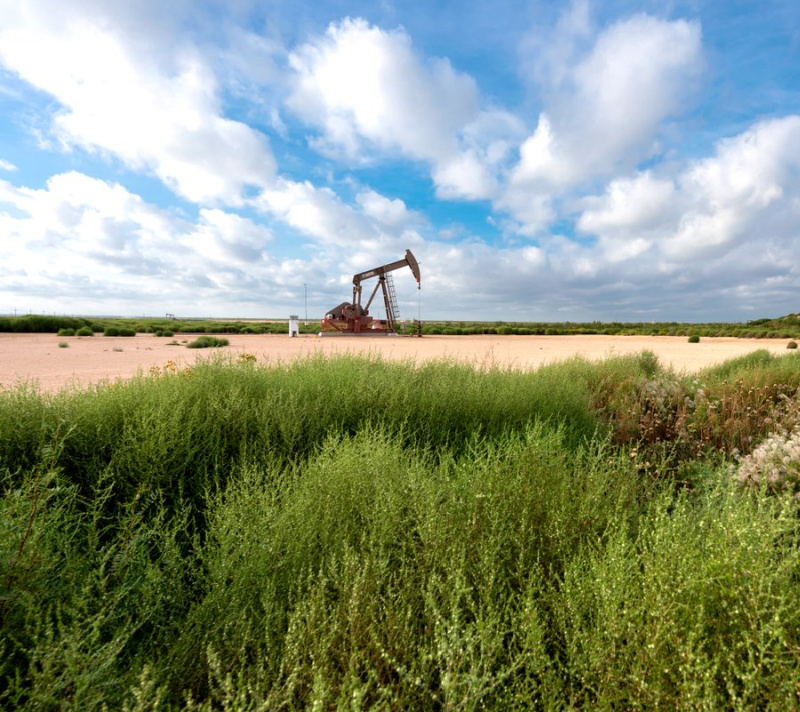
Ovintiv – public
Ovintiv operates primarily in the Anadarko and Permian basins with lesser operations in the Bakken and Uinta shales, the company’s website stated.
In its second-quarter 2021 supplemental report, Ovintiv reported a total of 310.8 Mboe/d produced among its U.S. operations, up from 292.8 Mboe/d in the first quarter. It produced 158.7 Mbbl/d of oil and plant condensate, an increase from 155.3 Mbbl/d the previous quarter. Total NGL production rose from 70.7 Mbbl/d in the first quarter to 79.7 Mbbl/d the following quarter, and natural gas production rose to 497 MMcf/d in the second quarter from 459 MMcf/d in the first quarter. Combined oil and NGL produced from U.S. operations totaled 227.9 Mbbl/d, an 11.6 Mbbl/d increase from the first quarter.
Ovintiv’s second-quarter 2021 production in the Permian averaged three gross rigs, drilled 21 net wells and had 33 net wells turned inline, according to its second-quarter 2021 results press release. The Anadarko averaged two gross rigs, drilled 16 net wells and had 22 net wells turned inline, 21 of which were operated by Ovintiv.
PDC Energy – public
PDC Energy operates primarily in the Denver-Julesburg Basin, with about 180,000 net acres in the Wattenberg Field, and secondarily in the Permian Basin, with about 25,000 net acres in the Delaware Basin, the company’s website stated.
PDC’s third-quarter 2021 earnings press release reported that the company’s crude oil production rose 1% to 4,925 Mbbl in the Wattenberg Field and 4% to 1,184 Mbbl in the Delaware Basin compared to the holdings’ production third-quarter 2020. Crude oil equivalent production rose 8% to 16,047 Mboe in the Wattenberg and decreased 6% to 2,717 Mboe in the Permian. Natural gas production rose 12% to 39,538 MMcf from 2020 in the Wattenberg but decreased 10% to 5,664 MMcf in the Delaware. Similarly, NGL production increased 13% to 4,532 Mbbl in the Wattenberg but fell 17% to 590 Mbbl from 564 Mbbl in the Permian.
In the Wattenberg Field, PDC operated one drilling rig and one completion crew, resulting in 20 spuds and 57 turned inline, according to the report. PDC had approximately 160 DUC wells by the end of the third quarter.
Pioneer Natural Resources – public
Pioneer Natural Resources is the largest producer in Texas with more than 900,000 net acres in the Permian Basin, with an average 2021 rig count of 22 to 24, in addition to over 500 wells being drilled in 2021, according to the company’s third-quarter 2021 earnings presentation.
Pioneer’s total Permian production in the third quarter was 675,770 boe/d, up from 629,434 boe/d in the previous quarter, the presentation stated. Oil production totaled 388,820 bbl/d in the third quarter, an increase from 363,033 bbl/d the previous quarter. NGL production increased from 147,124 boe/d in the second quarter to 156,863 boe/d in the third quarter, and gas production rose from 715,673 Mcf/d in the second quarter to 780,515 Mcf/d in the third quarter.
Pioneer completed its acquisition of Parsley Energy Inc. in January 2021, and the company acquired private operator DoublePoint Energy in second-quarter 2021. In fourth-quarter 2021, the company sold its Delaware Basin assets to Continental Resources, according to a press release issued Nov. 3.
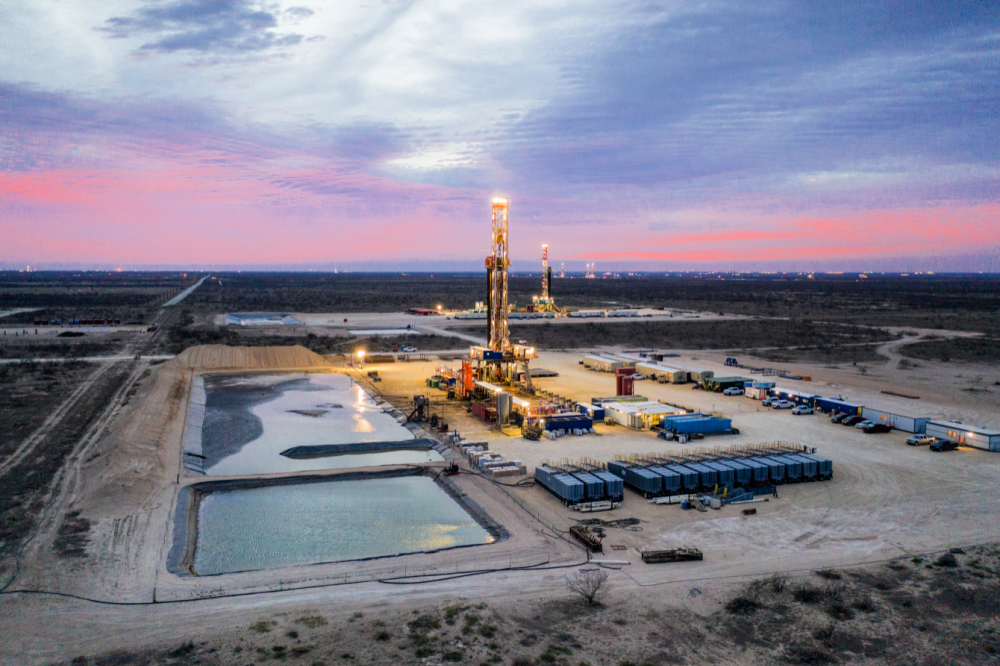
Range Resources – public
Range Resources Corp. is a top 10 U.S. producer of both natural gas and NGL with operations focused in the Appalachian Basin. Range operates approximately 1.5 million net effective acres in the core of the Appalachian Basin that includes potential from the Marcellus, Utica/Point Pleasant and Upper Devonian shales.
According to Range Resources’ third-quarter 2021 report, the company produced 137.7 Bcf of natural gas, 9.1 MMbbl of NGL and condensate production of 711,000 bbl, as total production from Appalachia increased approximately 1% compared to the prior year.
According to Range Resources, the company has the lowest development costs per unit of production in Appalachia. It has approximately 3,100 undrilled wells in the Marcellus with an estimated well inventory of 2,600 liquids rich wells and 500 dry gas wells.
Range has set emission reduction targets, including to achieve a goal of net zero direct greenhouse-gas emissions by 2025.
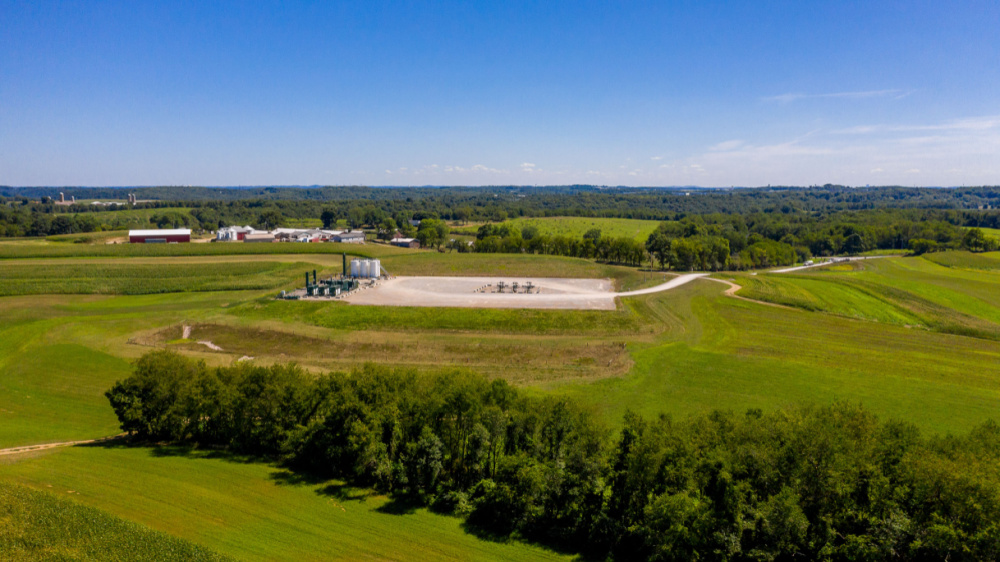
Rockcliff Energy – private
Rockcliff Energy is a private equity company operating in the Haynesville Shale with more than 270,000 net acres, of which more than 90% is HBP, according to the company’s website.
“We have built nine companies across various basins, commodities and economic cycles, all with outstanding project-level and corporate-level returns to our investors,” the website stated.
Rockcliff produced more than 1 Bcf/d from its assets in East Texas and has a strategic partnership with Trace Midstream.
“Rockcliff consistently keeps four rigs and two frac crews busy exploiting 156,000 net acres in Harrison and Panola counties, Texas, where the company has 1,000 future well sites that will keep Rockcliff busy in the area for a long time,” The American Oil and Gas Reporter reported in March 2021.
Shell – supermajor
Shell operated for years in the Delaware Basin of the Permian, but it sold its Permian assets to ConocoPhillips in late 2021.
“Shell Enterprises LLC, a subsidiary of Royal Dutch Shell Plc, has completed the sale of its interest in the Permian to ConocoPhillips for $9.5 billion in cash,” a Dec. 1 company press release stated. “The agreement covers the sale of Shell’s 225,000 net acres and existing production of around 175 thousand barrels equivalent per day.”
In Shell’s second-quarter 2021 and half-year unaudited results report, the company reported a total of 162,000 bbl/d of liquids production available for sale, compared to 170,000 bbl/d in the first quarter of the year. Shell also stated that it produced 4,502 MMscf/d in second-quarter 2021, decreasing 3% from 4,621 MMscf/d in first-quarter 2021.
Additionally, production of LNG liquefaction volumes fell 8% from 8.16 mT in the first quarter to 7.49 mT in the second quarter. Total production available for sale and LNG sales both decreased 3% within the first half of the year, with total production falling from 967,000 boe/d in the first quarter to 938,000 boe/d in the second quarter as well as LNG decreasing from 16.38 mT in the first quarter to 15.92 in the second quarter.
“Shell’s Shales business focuses on safely and responsibly producing gas, oil and their liquid components,” the company stated on its website. “We have robust GHG [greenhouse-gas] targets and—even with production ramp-up—we are on track to meet top quartile GHG intensity targets for our hydrocarbon assets by 2021 and gas by 2025.”
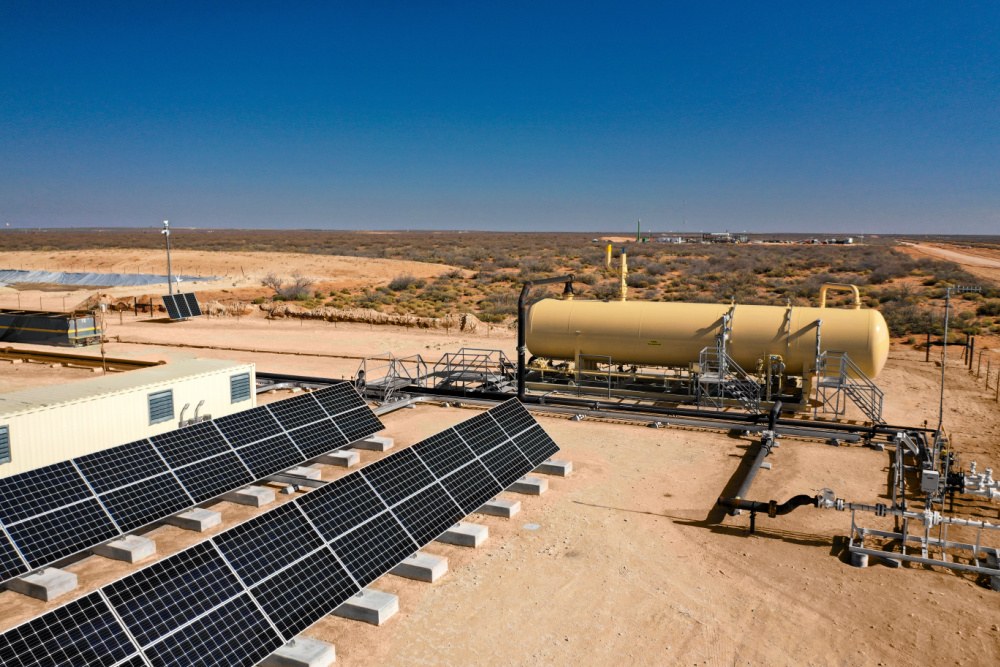
Slawson Exploration – private
Slawson Exploration Co., Inc. is a private E&P company based in Wichita, Kan., with unconventional operations in the Williston Basin.
“Beginning with its first strike in 1957 in Kansas, Slawson has drilled more than 4,000 operated oil and gas wells in 10 states,” Slawson’s website stated.
“Slawson continues to lead the way in the modern development of the Bakken Petroleum System in the Williston Basin,” a company spokesperson told Hart Energy. “It has drilled and completed over 525 wells using horizontal drilling and hydraulic fracturing technology since 2004. These include the individual well records within the basin for single-month oil production with 136,924 barrels, total measured depth at 28,186 ft and completed lateral length at 17,676 ft.”

SM Energy – public
SM Energy operates in the Maverick Basin (~155,000 net acres) in South Texas and the Midland Basin (~82,000 net acres) in West Texas. As of Sept. 30, 2021, the company had drilled 64 net wells and completed 97 net wells year-to-date, according to SM Energy’s website.
The company’s third-quarter 2021 operating and financial results highlighted production outperformance in both the Midland Basin and South Texas, which resulted in strong cash flows, SM Energy told Hart Energy. Third-quarter production was 155.8 Mboe/d and consisted of 56% oil, 34% natural gas and 10% NGL. Total third-quarter production increased 14% from the previous quarter and 23% from compared with the prior year period. Oil, natural gas and NGL production increased 19%, 9% and 6%, respectively, compared with the previous quarter. Production from the Midland Basin represented 68% of total production for the quarter.
The company’s third-quarter production outperformance was related to higher base production, reduced flaring and the effect of larger fracture stimulations in the Midland Basin and the successful early completion of certain wells in South Texas, SM Energy told Hart Energy. The larger fracture stimulations in the Midland Basin were highlighted during the company’s latest earnings call.
President and CEO Herb Vogel stated in the third-quarter report, “On the ESG front, operations and IT have teamed up with a new effort to focus on evaluating and implementing emerging field technologies that will help the company measure, monitor and decrease emissions. The team has already initiated a pilot project at Sweetie Peck [in Texas] with technology to provide continuous methane monitoring.”
Southwestern Energy – public
Southwestern Energy operates in the Appalachian Basin (789,000 net acres) and the Haynesville Shale (275,000 net effective acres, 149,000 net surface acres), according to the company’s website.
In Southwestern’s latest quarterly results press release, the company reported NGL production at 8,011 Mbbl in the third quarter, up from 6,687 Mbbl during the same time in 2020. Oil production totaled 1,729 Mbbl compared to 1,294 Mbbl the previous year, and gas production totaled 251 Bcf, increasing from 173 Bcf in third-quarter 2020. Total production in Appalachia was 280 Bcfe, and Haynesville total production was 30 Bcf after the acquisition of assets in early September. Between the two shales, Southwestern drilled 17 wells, completed 23 wells and placed 24 wells to sales.
On Sept. 1, Southwestern completed the $2.7 billion acquisition of Indigo Natural Resources. The company updated its total year guidance to reflect the additional production from the acquisition, increasing it to 1,217 Bcfe to 1,235 Bcfe. In fourth-quarter 2021, the company also agreed to acquire GEP Haynesville by year-end 2021, according to a press release issued Nov. 4.
Recommended Reading
For Sale, Again: Oily Northern Midland’s HighPeak Energy
2024-03-08 - The E&P is looking to hitch a ride on heated, renewed Permian Basin M&A.
Gibson, SOGDC to Develop Oil, Gas Facilities at Industrial Park in Malaysia
2024-02-14 - Sabah Oil & Gas Development Corp. says its collaboration with Gibson Shipbrokers will unlock energy availability for domestic and international markets.
E&P Highlights: Feb. 16, 2024
2024-02-19 - From the mobile offshore production unit arriving at the Nong Yao Field offshore Thailand to approval for the Castorone vessel to resume operations, below is a compilation of the latest headlines in the E&P space.
E&P Highlights: Feb. 26, 2024
2024-02-26 - Here’s a roundup of the latest E&P headlines, including interest in some projects changing hands and new contract awards.
CEO: Continental Adds Midland Basin Acreage, Explores Woodford, Barnett
2024-04-11 - Continental Resources is adding leases in Midland and Ector counties, Texas, as the private E&P hunts for drilling locations to explore. Continental is also testing deeper Barnett and Woodford intervals across its Permian footprint, CEO Doug Lawler said in an exclusive interview.





